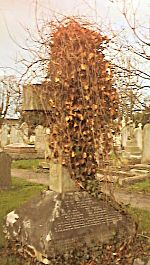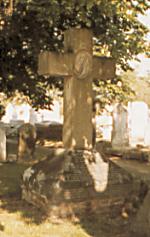Location
In Kingston Cemetery. The monument is situated about 50m from the gate on St Mary's Road , set back behind the first row of graves on the left.
Description
The memorial is about 3 metres high and appears to be made of sandstone. In February 2002 it was considerably overgrown by ivy. By 2006 this had been removed.

Memorial (1990)

HMS Ariadne

Specifications
Dimensions: 280x50x21ft
Engine: Maudsley 3350ihp
Armament:24-10in ML SB
Complement: 450
Launched: Nov 1859
Fate: Sold 1922
Designed by Sir Baldwin Walker.
SUB LIEUT WILLM A JUKES
SUB LIEUT WILLM J TALBOT
RICHARD BAILEY. COXSN OF CUTTER
ORDY SEAMEN
JOHN RENOUF WILM HEANEY
JOHN S SQUIRE FELIX RICHARDSON
JAMES C HEWSON SAML BLACKBURN
FRED HOLLAND RICHARD H THOMAS ORD 2ND CLASS
LATE OF HMS ARIADNE WHO ON THE 8TH MARCH 1872 OFF THE COAST OF PORTUGAL WHEN THE SHIP WAS PROCEEDING TO GIBRALTAR WERE CAPSIZED IN THE 2ND CUTTER AND DROWNED WHILST BRAVELY ATTEMPTING IN A HEAVY SEA TO RESCUE AN UNFORTUNATE SHIPMATE WHO HAD FALLEN OVERBOARD
THIS MONUMENT IS ERECTED BY THE OFFICERS AND SHIPS COMPANY OF THE ARIADNE TO RECORD THEIR ADMIRATION OF THE HEROIC EFFORTS MADE BY THE GALLANT OFFICERS AND CREW UNDER CIRCUMSTANCES OF EXTREME PERIL AND TO EXPRESS THE GREAT GRIEF FELT BY ALL ON BOARD AT THEIR UNTIMELY FATE
Further Information
The Times 19.3.1872 (11 c)
Dreadful loss of Life at Sea.
We have received from the Admiralty the following correspondence:-
Her Majesty's Ship Ariadne, Gibraltar, March 11.
Sir, - It is my painful duty to report the very large and lamentable loss of life which occurred on the morning of Friday, the 8th inst. in lat. 40.15N, long. 12.10.W., 130 miles distant from the coast of Portugal, between Oporto and Lisbon, when Mr. Jukes, sub-lieutenant, and Mr. Talbot, sub-lieutenant and eight seamen perished in the gallant but unsuccessful attempt to save the life of a seaman who had fallen overboard, making the total loss two sub-lieutenants and nine seamen - in all, 11 lives.
I have also to report the loss of both quarter boats with all their gear. I will endeavour to give in detail as exact account of what happened.
On the morning of the 8th last, about 6 o'clock, the foot ropes of the maintopsail (a half-worn sail) carried away, and the sail split, Soon afterwards in re-setting the maintopgallant sail, Felix Richardson (ordinary) fell overboard from the maintopmast crosstrees. The ship was then running under single-reef topsails and foresail, with a strong breeze from W.N.W. on the starboard quarter, with a long heavy following swell, causing the ship to roll heavily; the force of wind 6 to 7; the speed of ship 9½ to 10 knots.
The ship was immediately brought to the wind on the starboard tack and hove to, and the cutter was lowered and pulled in the direction of the man. When the boat was clear of the ship, she behaved well, and made good way against the wind and sea, and I apprehended no danger to her.
Soon after 8 o'clock, finding that the ship was drifting considerably to leeward of the boat, and the wind increasing, with heavy squalls, I hoisted the cutter 'recall', and having lowered the screw and furled the sails, was enabled to commence steaming to windward in the direction of the cutter at 9.50a.m. After steaming for a few minutes she was observed to have borne up before the wind and to be pulling towards us.
On nearing the boat and in rounding the ship in order to place her under our lee, I saw the crest of a heavy sea take her broadside on as she was endeavouring to turn head to wind, which instantly capsized her and completely swamped her.
Having rounded the ship close to windward of the swamped boat, to which several of the crew were clinging, as well as to the scattered boat's gear, an attempt was made to lower the starboard cutter but, unfortunately, owing to the after-fall fouling on the boat, she was immediately swamped, and her crew and officers placed in great peril, all of whom were picked up with the exception of one man, William Heaney, ordinary seaman, who was lost.
It now only remained to place the ship in such a position as to drift over the wreck of the first boat, and to save life as best we could by throwing ropes, and gratings, etc. to the men in the water. This was done under considerable difficulty, owing to the heavy swell, the strong wind, and the great length of the ship, snd we succeeded in saving four men.
The ship was kept under steam among and around the debris of the wrecked boat for a considerable time, until all possible hope of any survivors had vanished, and, finally, we bore up under sail for Gibraltar.
The four men saved from the second cutter all agree that the boat behaved admirably, without shipping any water of any consequence till the moment she was swamped by the sea breaking, and taking her on the broadside in the unfortunate attempt of bringing her head to wind; they all say that Mr Jukes and Mr. Talbot were among the first to be washed away. While deeply lamenting the loss of these young officers, one of whom was a near relative of mine, it is a sad pleasure and consolation to be able to speak to the high merits of both of them, who have always shown zeal in the performance of their duty, and were ever foremost in cases of danger and saving life, and had gained the respect and affection of all who knew them.
The bright side remains this sad narrative - namely, the promptness and alacrity in executing orders on the part of the officers and ship's company in a moment of great anxiety and excitement, when it was necessary to work the yards, head and after sails, in conjunction with the steam, to lay the ship in exact position for rescuing life, in which service I was ably assisted by Staff-Commander Founds.
I think it only my duty to bring to notice, for favourable consideration of my Lords Commissioners of the Admiralty, the conduct of Lieutenant Brealey, Mr. Egerton, midshipman, and the crew of the first cutter, who, having seen the other boat swamped, willingly risked their lives in order to help their shipmates, with the unfortunate result alrady stated.
It is also my desire to especially report the gallant conduct of Mr. Ellis, boatswain, second class, borne for the instruction of cadets (a survivor from the late Her Majesty's Ship Captain) and George Loram, quartermaster, who, at great peril of their lives, went down with slip-ropes under the port-quarter of the ship to attempt rescuing a drowning man; but the heavy swell and rolling of the ship rendered it impossible and Mr. Ellis narrowly escaped with his life.
I have the honour to append a nominal list of the gallant officers and men who were lost on the occasion, as well as a list of the four men saved from the second cutter.
I have the honour, etc.
W.C.Carpenter (Captain)
Officers and Men lost in second cutter:-
William A Jukes, sub-lieutenant
William J. Talbot, do.
William Renouf, ordinary
Richard H. Thomas Ordinary 2nd Class
Richard Bailey coxswain of cutter
John S Squires Ordinary
James G. Hewson do.
Federick Holland do.
Samuel Blackburn do.
Lost at swamping of first cutter;-
William Heaney ordinary
Fell Overboard
Felix Richardson ordinary
Men Saved
Samuel Merchant ordinary
Stephen Hazleton do.
Henry Lynbey do.
John Marshall do.
Ariadne was one of 6 ships generally known as 'Walker's Big Frigates.'
These ships played an important role in the development of the masted steam cruiser, for it could be said that they anticipated the battlecruiser of the Fisher era as their speed, with weight of armament, enabled them to act as a fast division with the battle fleet. The decision to build these ships was precipitated by the action of the United States Navy which in 1854 authorised the construction of five powerful steam frigates and one steam corvette. To meet this challenge, Sir
Baldwin Walker designed these frigates. The first, Diadem, had already been laid down as a sailing frigate and was convened to screw, whilst her sister ship was built as a screw vessel from the laying other keel. The size of these ships increased in three stages, with the last pair being the longest wooden ships ever built for the Royal Navy. There were two designs, based on experience gained in the Crimean War, to select from. The first was a ship with long range gunfire and suf-
ficient speed to keep outside the range of any adversary, but armed heavily enough to destroy her opponent. The second design was for an armour-protected ship built to fight at short range where weight of armour and gun power would be more essential than speed. The navy opted for speed
and heavy armament and the first design was chosen. In the event, these ships proved to be faster and more heavily armed than the American big frigates. It has been said that Orlando and Mersey were unable to withstand the stresses of their powerful engines, hence the reasons for their comparatively short service life. But it would seem that they really were too large and expensive to maintain in upkeep and manpower for the duties demanded of cruising ships in midVictorian times
From the constructional point of view, these vessels incorporated all the features of a sailing frigate, and demonstrated a definite link between ships-of-the-line and the navy's first armoured capital ship, Warrior. The lower deck accommodated the ship's complement; the 10in shell guns were
mounted on the main deck; and the 32pdr and 68pdr guns were on the upper deck. Not long after commissioning Ariadne and Galatea received Armstrong 1 lOpdr BL slide-mounted guns in place of their pivoted 68pdrs. They all had the old-fashioned rectangular boilers operating at about 20psi. Their HSE trunk engines were impressive in size, the cylinders being nearly eight feet in diameter.
